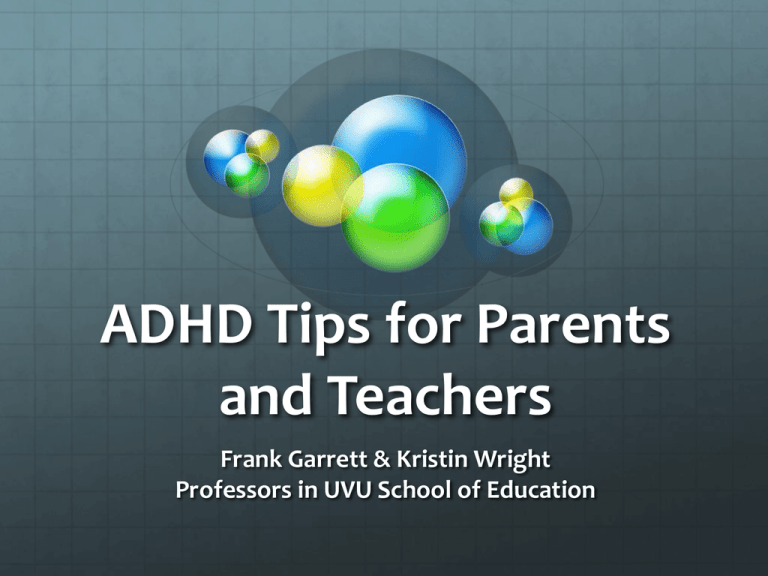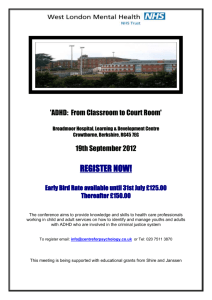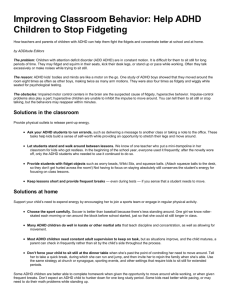ADHD Tips for Parents and Teachers
advertisement

ADHD Tips for Parents and Teachers Frank Garrett & Kristin Wright Professors in UVU School of Education “Children with ADHD generally have deficits in executive function: The ability to think and plan ahead, organize, control impulses, and complete tasks. We have to take over as the executive and provide guidance. It is important to remember that the child with ADHD who is ignoring, annoying or embarrassing you is not acting willfully. Kids with ADHD want to sit quietly; they want to make their rooms tidy and organized; but they don’t know what to do. They don’t know how to make these things happen.” Helpguide.org ADHD affects others Parents Peers ADHD Educators Siblings In order to meet the challenges of raising a child with ADHD, you must be able to master a combination of compassion and consistency. Here are 7 tips for parents to provide love and structure for a child or teenager who is learning to manage ADHD. Tip 1: Stay positive and healthy yourself Keep things in perspective. Don’t sweat the small stuff and be willing to make some compromises. Believe in your child. Take care of yourself Seek support Take breaks Tip 2: Establish structure and stick to it Follow a routine. Use clocks and timers. Simplify your child’s schedule. Create a quiet place. Do your best to be neat and organized. Keep them busy: especially on physical activities Tip 3: Set clear expectations and rules Children with ADHD need consistent rules that they can understand and follow. Children with ADHD respond well to organized systems of rewards and consequences. Stick to the rules and follow through. Often they receive criticism. Be on the lookout for good behavior-praise it. Use rewards and consequences that are meaningful to the child or adolescent. Tip 4: Encourage movement and play Engage in physical play to burn off energy. Decrease television and technology time. Eliminate caffeine. Create a buffer time to lower down activity level for an hour before bedtime. Use lavender and other aromas in their room. Use relaxation tapes as background noise. Tip 5: Help your child eat right. Eating small meals more often help with ADHD. Get rid of the junk foods in the home. Put fatty and sugary foods off-limit when eating out. Turn off television shows riddled with junk-food ads. Give your child a daily vitamin-and-mineral supplements. Tip 6: Teach your child how to make friends They often have difficulty with simple social interactions. They are intelligent and creative. Speak gently but honestly. Make time and space to play and reward good play. Role-play various scenarios and invite one or two friends at a time. Have zero tolerance for hitting, pushing and yelling. Tip 7: Provide frequent feedback Establish routines . ADHD kids are bored with them, but they need them. Create a reward system that is something they want and enjoy. It does not have to cost money. Focus on the positive. Tell them when they are doing something well. Plan for problems. Talk them out. Teaching Students with ADHD You are a teacher. You know these kids. Think of what the school setting requires children to do. Sit still. Listen quietly. Pay attention. Follow instructions. Concentrate. Students with ADHD pay the price for their problems in low self-esteem, teasing from peers, scolding and punishment, low grades. You take complaints from parents because kids are being cheated of your instruction and you can’t reach the child. What teachers can do to help You need lots of patience, consistency and creativity. Successful programs integrate three components: (1) Accommodations: what you can do to make learning easier. (2) Instruction: methods you use (3) Intervention: How to head off behaviors, use warning signals Classroom Accommodations Seating: Away from windows and doors. Information delivery: Give instructions one at a time and work on most difficult materials. Student work: Create a quiet area free of distractions. Worksheets and test with fewer items. Reduce timed tests. Do most of the work on computer. Accept late work and give partial credit. Divide long-term projects into segments and assign a completion goal for each segment. Organization Have the student keep a notebook, a 3 ringed binder or three pocket assignment notebook insert for homework, completed assignments and “mail” to parents. Make sure things go into the binder. Teaching Techniques Starting a lesson: Signal the start of a lesson with a cue, timer. List the activities of the lesson on the board. Tell students what they are going to learn and what your expectations are and the materials they need. Tell them the purpose of the lesson and activities. Establish eye contact. Conduct the lesson in a variety of ways. Be enthusiastic. Involve students in lesson with their responses. Techniques Keep instructions simple and structured. Have a study buddy who is willing & able to assist and redirect Vary the pace and include many activities that are rapid and intense. Use props, charts, and other visual aids. Have a cue set like a touch on a shoulder, a sticky note. Allow frequent breaks. Use squeeze toys or tap something quietly. Try not to ask them to perform a task or answer a question that may be difficult. (especially in front of others) End the lesson and summarize key points. Techniques & Accommodations Circulate around the room to check for understanding & on task behavior Get to know their specific struggles, strengths, learning styles, and how they like to show you what they have learned. (computer, orally, art, music, skit or drama) Provide students with study guides for tests of what you need them to know. If you give an assignment, have three different students repeat it and then have the class say it in unison and put it on the board. Try to always have direction in writing. Be specific about what is to be taken home. Check to see they take it home. More Accommodations Remember you can differentiate their assignments – shorten it, make it easier, give them more time, provide simpler materials on their level, work in pairs or groups, how they present what they know. Testing Accommodations: More time, quiet area or room, shortened test, different test, re-test, takehome test, provide study guides, study in pairs/groups, open book/notes, provide word bank Provide students with a copy of your notes, outlines, power points. Creative Techniques: “Make learning fun!” Play games with material to be learned Draw pictures; Use visual art for academic purposes Invent silly acronyms. Make up a song or phrase. Read to children Make predictions or bets Act out a story – use drama for academics Productive physical movement learning activities “Doing” Matters “I hear – I forget I see – I remember I do – I understand” A Chinese Proverb The “Fairness Rule” Since I give different work to students based on their need, I tell ALL students this: “Fairness does not mean everyone gets the same. It means that everyone gets what they NEED.” A change in attitude - ours We have to teach the children we have – not the children we used to have, not the children we want, not the children of our dreams. Parents are sending us the best kids they have. Do you really think they’re keeping the good or better ones at home? Sometimes your classroom is the most stable environment that some kids have. Look at ADHD as a “gift”, and what you do for this child will make all the difference in his/her success in life. “Life isn’t how you survive the storm; it’s about how you danced in the rain” Gordon B. Hinckley







